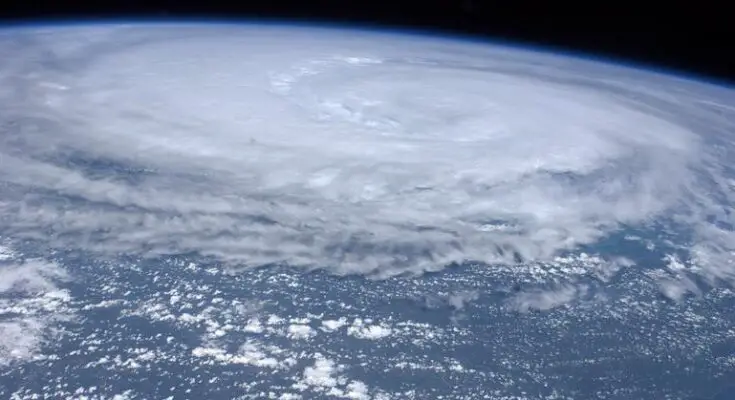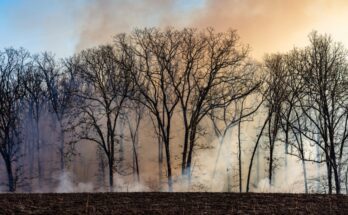When discussing the distinction between hurricanes and tornadoes, one must think about their beginnings, magnitude, ferocity, and destruction they bring. These powerful weather phenomena have unique characteristics that set them apart from each other.
In this blog post, we will delve into the formation processes of hurricanes and tornadoes by examining their oceanic origins and connections to supercell thunderstorms. We will also explore how seasonality affects these extreme weather events in various regions around the world such as hurricane-prone areas and Tornado Alley.
Additionally, we’ll compare their lifespans, categories or ratings based on sustained winds or strong winds for hurricanes versus Enhanced Fujita Scale ratings for tornadoes. This comparison will help us understand the potential destruction caused by both types of storms.
Furthermore, we’ll discuss an interesting phenomenon where hurricanes can spawn tornadoes under certain meteorological conditions. Lastly, we’ll touch upon climate change’s impact on future storm frequency and intensity while suggesting strategies for adapting communities vulnerable to these extreme weather events.
This in-depth exploration seeks to equip you with a greater comprehension of the primary distinctions between hurricanes and tornadoes, as well as illuminating some less known facets associated with these remarkable phenomena.
Table of Contents:
- Formation of Hurricanes and Tornadoes
- Seasonality and Regions Affected
- Size, Duration, and Intensity Differences
- Damage Caused by Hurricanes vs Tornadoes
- Hurricanes and Tornadoes: A Deadly Combination
- Climate Change Impacts on Hurricanes and Tornadoes
- FAQs in Relation to Difference Between Hurricane and Tornado
- Conclusion
Formation of Hurricanes and Tornadoes
Hold on to your hats, folks. Ready to explore the exciting world of hurricanes and tornadoes? These two weather phenomena may seem similar, but they actually form under very different conditions. Hurricanes tend to brew over warm ocean waters near the equator, while tornadoes usually form over land during supercell thunderstorms.
Oceanic Origins of Hurricanes
Warm ocean waters create a low-pressure system at the surface, which then begins to spin due to Earth’s Coriolis effect and is propelled westward by trade winds until it develops into an immense storm. As this system grows, it starts to spin thanks to Earth’s Coriolis effect. Trade winds then push these storms westward across the ocean until they become massive storm systems.
Supercell Thunderstorms Leading to Tornado Formation
Tornadoes, on the other hand, form within supercell thunderstorms. These storms contain powerful updrafts that lift air rapidly upward while also causing it to spin around a central core. When this rotating column of air extends down towards the ground, it forms into a tornado.
For these atmospheric vortices to develop, specific environmental factors must be present, such as sufficient moisture content in lower levels of the atmosphere and temperature gradients between upper-level cold fronts colliding with warmer surface air masses. These conditions create ideal circumstances for powerful storm systems capable of producing tornadoes.
Now that we know how hurricanes and tornadoes form, let’s explore their differences in seasonality, regions affected, size, duration, and intensity levels. Understanding these natural disasters’ impacts on our lives and environment can help us develop strategies for mitigating potential damages caused by them. For more interesting facts, check out InterestingFacts.org.
Seasonality and Regions Affected
Hurricanes and tornadoes have distinct peak seasons, primarily affecting specific regions around the world. Most hurricanes hit the US during summer and early fall when ocean temperatures are at their warmest. In contrast, tornadoes have a peak season between March to early June across Tornado Alley – an area stretching from Texas to South Dakota known for its frequent occurrence of these atmospheric vortices.
Hurricane-prone regions around the world
Trade winds in the Northern Hemisphere fuel hurricane formation, often occurring over the Atlantic and Pacific oceans near the equator. These powerful weather systems typically affect areas such as:
- Caribbean Sea region
- Gulf of Mexico coastlines
- Eastern seaboard of North America (from Florida up to New England)
- Western coasts of Central America and Mexico
- Pacific islands like Hawaii or Guam
The infamous Tornado Alley
Tornado activity in the United States is concentrated within a region called “Tornado Alley,” which includes parts of several states:
- Texas
- Oklahoma
- Kansas
- Nebraska
- South Dakota
- North Dakota
- Colorado
- Missouri
So if you’re planning a trip to any of these areas, make sure to pack your raincoat and hold onto your hat.
Size, Duration, and Intensity Differences
Hurricanes can last for days or even weeks, affecting larger regions. Check out the National Hurricane Center for more information. In contrast, tornadoes have relatively shorter lifespans lasting anywhere from minutes to hours at most.
Lifespans of Hurricanes versus Tornadoes
Hurricanes are much larger than tornadoes and can span hundreds of miles in diameter. They typically form over warm ocean waters and gain strength as they travel across the sea. Once it arrives onshore, a hurricane’s power diminishes but can still cause extensive destruction through torrential rains, flooding, high winds and even mini-tornadoes. The lifespan of a hurricane ranges from several days up to two weeks or more depending on various factors such as wind shear and water temperature.
Tornadoes usually develop during powerful thunderstorms when strong updrafts interact with horizontal winds creating rotation within the storm system. Tornado paths tend to be narrower compared to hurricanes covering only a few miles before dissipating entirely.
Comparing Hurricane Categories with Enhanced Fujita Scale Ratings
Hurricanes are classified into five categories based on their sustained wind speeds using the Saffir-Simpson Hurricane Wind Scale. Category 1 hurricanes have wind speeds of 74-95 mph, while Category 5 storms exhibit winds greater than 156 mph. The damage potential increases with each category, ranging from minimal to catastrophic.
Tornadoes are rated using the Enhanced Fujita Scale (EF0 – EF5) based on their estimated wind speeds and associated damage levels. An EF0 tornado has winds between 65-85 mph causing light damage, whereas an EF5 tornado can produce devastating winds over 200 mph resulting in complete destruction of buildings and infrastructure.
It’s important to understand these differences in size, duration, and intensity for emergency preparedness efforts and developing strategies to mitigate the impacts of these powerful natural disasters on communities around the world. Stay safe.
Key Takeaway:
Hurricanes and tornadoes differ in size, duration, and intensity. Hurricanes can last for days or weeks while tornadoes have shorter lifespans lasting from minutes to hours. Hurricane categories are based on sustained wind speeds whereas tornado ratings use the Enhanced Fujita Scale to estimate wind speeds and associated damage levels.
Damage Caused by Hurricanes vs Tornadoes
Both natural disasters can be devastating, but they differ in the types of damage they inflict and the areas affected.
Wind speeds and potential destruction from hurricanes
Hurricanes generate powerful winds that can reach speeds of up to 157 miles per hour or more in Category 5 storms. These gusts can topple trees, power lines, and even entire buildings. Hurricanes can bring devastating consequences, such as torrential rains leading to flooding and storm surges that cause property destruction and loss of life; for instance, Hurricane Andrew caused an estimated $26 billion worth of damage in Florida in 1992. In 1992, Hurricane Andrew inflicted an estimated $26 billion worth of destruction in Florida.
The destructive power of tornadoes based on EF ratings
Tornadoes follow a six-point scale called the Enhanced Fujita Scale (EF0 – EF5), where higher ratings correspond with stronger gusts capable of reaching speeds above 200 miles per hour. An EF4 tornado, for instance, can level well-built houses and cause devastating impacts on infrastructure like bridges and highways. Tornadoes typically cause destruction along a narrower path compared to hurricanes, but the intensity of the damages can be much greater due to their concentrated force. For example, the devastating Moore Tornado in Oklahoma resulted in widespread destruction and loss of life within its relatively small path width of just over one mile wide at times during its track across Moore and southern parts of Oklahoma City metro area.
EF Scale Ratings:
- EF0: Light damage with wind speeds between 65-85 mph.
- EF1: Moderate damage with wind speeds between 86-110 mph.
- EF2: Considerable damage with wind speeds between 111-135 mph.
- EF3: Severe damage with wind speeds between 136-165 mph.
- EF4: Devastating damage with wind speeds between 166-200 mph.
- EF5: Incredible damage with wind speeds over 200 mph.
When it comes to natural disasters, it’s important to be prepared for the worst. Stay informed and stay safe.
Key Takeaway:
Hurricanes and tornadoes are both natural disasters that can cause significant damage, but they differ in the types of destruction they inflict. Hurricanes generate powerful winds and flooding, while tornadoes follow a six-point scale called the Enhanced Fujita Scale (EF0 – EF5) with concentrated force capable of devastating impacts on infrastructure. It’s important to be prepared for these disasters by staying informed and safe.
Hurricanes and Tornadoes: A Deadly Combination
When hurricanes hit land, they can bring with them a destructive force that many people don’t consider: tornadoes. These twisters can cause even more damage and devastation, making it crucial to understand how they form and how to prepare for them.
How Hurricanes Spawn Tornadoes
When a hurricane meets up with other meteorological systems, it can produce wind shear – an alteration in airspeed and direction at distinct heights. This can cause the air to rotate horizontally, which can then tilt vertically and form a tornado when it gets caught up in a thunderstorm’s updrafts. The warm, moist air in a hurricane provides the perfect environment for these twisters to develop.
Examples of Hurricane-Spawned Tornadoes
- Hurricane Ivan (2004): Produced over 100 confirmed tornadoes across nine states, causing widespread destruction and several fatalities.
- Hurricane Rita (2005): Spawned around 90 confirmed tornadoes throughout six states, causing damage and power outages.
- Hurricane Harvey (2017): Produced more than 50 tornadoes in the Houston area alone, adding to the already catastrophic damage caused by the hurricane.
It is essential for those living in areas prone to hurricanes to be aware of weather conditions, have access to timely warnings and secure places of refuge during such calamitous events. This includes understanding local weather patterns, having a reliable communication system for severe weather alerts, and establishing designated safe spaces for shelter during extreme events.
Climate Change Impacts on Hurricanes and Tornadoes
Anxiety is rising over how global warming may affect hurricanes and tornadoes. Research shows that powerful hurricanes may become more common, dumping more rain and increasing the risk of severe flooding. Understanding their dynamics and developing strategies for mitigating potential damages is crucial.
Increased frequency and intensity of future storms due to climate change
Rising global temperatures are expected to increase extreme weather events like hurricanes and tornadoes. Warmer ocean waters provide more energy for storm systems, leading to stronger storms with higher wind speeds. A warmer atmosphere can hold more moisture, resulting in heavier rainfall during these events. This could mean a rise in both the occurrence and severity of hurricanes and twisters in susceptible areas.
Strategies for adapting communities vulnerable to these extreme weather events
To protect lives and property from the devastating impacts of powerful storms, communities must develop comprehensive adaptation strategies tailored to hurricane-prone or tornado-prone areas:
- Improved infrastructure: Strengthening buildings against high winds by using reinforced materials or designs can help reduce damage caused by strong gusts during extreme weather events.
- Better early warning systems: Accurate forecasting allows residents ample time to prepare themselves and their properties for incoming storms, potentially saving lives and reducing property damage.
- Enhanced flood protection: As hurricanes become more likely to produce heavy rainfall, communities must invest in improved drainage systems or levees to prevent widespread flooding.
- Educating the public: Ensuring that residents are aware of the risks associated with extreme weather events can help them take appropriate precautions when a storm is imminent. This includes understanding evacuation routes and having emergency supplies on hand.
By researching these phenomena and implementing proactive measures designed specifically for vulnerable regions, we can minimize potential damages while ensuring greater resilience against future extreme weather events.
Key Takeaway:
Climate change is expected to increase the frequency and intensity of hurricanes and tornadoes. To mitigate potential damages, communities must develop adaptation strategies such as improved infrastructure, better early warning systems, enhanced flood protection, and educating the public about risks associated with extreme weather events.
FAQs in Relation to Difference Between Hurricane and Tornado
Tornado vs. Hurricane: What’s the Difference?
Tornadoes and hurricanes differ in formation, size, duration, and impact, with tornadoes forming from supercell thunderstorms over land and hurricanes developing over warm ocean waters.
While hurricanes are larger systems lasting days to weeks, tornadoes have shorter lifespans of minutes to hours.
Both can produce torrential rain leading to flooding, but hurricanes cause widespread damage through high winds, storm surges, and flooding, while tornadoes inflict localized destruction with intense winds.
Similarities and Differences Between Hurricanes and Tornadoes
Both involve powerful rotating wind systems, but hurricanes cover hundreds of miles while tornadoes span just a few hundred yards.
While hurricanes originate from tropical disturbances over oceans, tornadoes emerge from severe thunderstorms on land.
Both can produce torrential rain leading to flooding.
Tornado vs. Hurricane for Kids: What’s the Difference?
A hurricane is like an enormous spinning storm that forms over warm ocean water with heavy rain and strong winds spreading out far across many miles.
A tornado is much smaller than a hurricane but has even stronger swirling winds that can cause lots of damage within its narrow path on land.
Which is Stronger: Hurricane or Tornado?
Tornadoes can have stronger localized wind speeds, but hurricanes cause more widespread damage due to their size and storm surge.
Tornado strength depends on the Enhanced Fujita Scale rating (EF0-EF5), which measures wind speeds up to 300 mph, while hurricane intensity uses categories 1-5 based on Saffir-Simpson Hurricane Wind Scale, with maximum sustained winds reaching 157 mph or higher.
Sources: National Hurricane Center, National Oceanic and Atmospheric Administration.
Conclusion
Preparing for extreme weather events requires understanding the difference between hurricanes and tornadoes.
Hurricanes originate over oceans and can last for days or weeks, while tornadoes form from thunderstorms and typically only last a few minutes.
Both storms have their own seasonality and regions affected, with hurricanes being more common in coastal areas around the world and Tornado Alley seeing the most frequent tornado activity.
The damage caused by each storm varies based on factors such as wind speed and intensity ratings, and it’s important to note that hurricanes can also spawn tornadoes during their lifespan.
With climate change impacting future storm frequency and intensity, communities must adapt to mitigate potential destruction from both types of storms.



